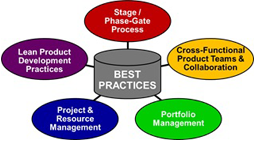To survive in this era of competition, every company needs to offer new products and services to their clients. But bringing out a new product and popularizing it to the customers isn’t easy, particularly if you don’t use a holistic product development approach. It needs proper understanding of the nature of market, requirements of the customer, cost, time and quality. That’s the reason why you should follow a full-fledged product development process that uses different variables to develop continuous practices and strategies for design, implementing and marketing a product in the market. The steps to this process are-
Idea Generation:
Idea generation is crucial for product development process. When a new product is supposed to be launched, the organization or enterprise has to think of something that’s valuable for the customers. Therefore, through the use of product development software, the company should go for SWOT Analysis, wherein every idea’s strength, weakness, opportunities and threats are deliberated and discussed. Brainstorming for a new product, analysing it is essential before moving on to the next step.
Idea Screening:
Once a few ideas have been brainstormed, the team should move onto the concept of idea screening, where unsound concepts are cleared to avoid wasting time. Ideas are screened for their potential or target market size and growth forecasts, current competitions, industry sales and trends, profitability and whether or not it is technologically feasible.
Idea Development and Testing:
Once one or more ideas are chosen upon, they are developed and tested. For instance, their engineering details will be developed, so as their marketing plan and product features. Then, it shall be tasted in a sample of target market to know their reaction and whether or not the product is deemed as cost-effective. Product feasibility is also taken to consideration.
Business Analysis:
Estimations are made regarding the product, based on customer feedback and market competitors. Its profitability and break-even point shall also be taken into consideration.
Beta and Market Testing:
Product’s physical prototype or mock up is tested in the market, more often in its typical usage situations. Conduction of studies and introduction at product launches or trade shows. According to the initial reports, special adjustments are made and initial run is done to the market to see whether it is accepted by the customers.
Technical Implementation:
A quality management system is finalized for the product, along with resource estimation. A logistics plan is designed along with resource plan publication and contingencies (if needed).
Commercialization:
The process involves proper launch of the product in the market, along its critical path analysis. The distribution pipeline is filled with the product. Advertisement, online and offline promotion system is established for marketing the product among masses.
New Product Pricing:
This is the last step in product development process. It involves value analysis of the product, alternative competitive technologies and product costs deliberations. Product prices are selected along with a forecast for volumes, profits and revenue.

